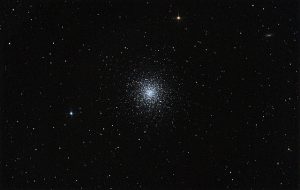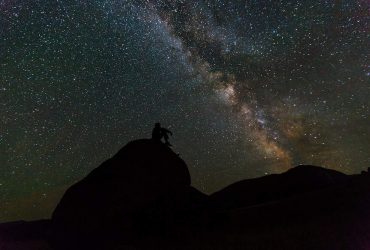Summer Stargazing with Binoculars
The summer months are a veritable gold mine for astronomy enthusiasts, as there are several fantastic celestial phenomena to observe during this exciting season.
While the telescope seems to be the most popular choice for summer stargazing excursions, you would do well not to overlook binoculars as an effective observation tool for astronomy.
Compared to telescopes, binoculars have a much more generous field of view, they don’t require any setup, and they’re highly portable, making them the perfect “grab-and-go” instrument for those impromptu stargazing sessions.
Not only that, but many people find binoculars to be easier on the eyes than telescopes, because you are not required to keep one eye shut in order to observe celestial objects.
Binoculars are an ideal choice for beginning stargazers in particular; in fact, it is not uncommon for amateur astronomers to “cut their teeth” on binoculars for several months or even years before advancing to telescopes.
Popular Summer Stargazing Targets for Binoculars
There are several popular stargazing targets that you can observe with binoculars during this summer season. If you’re using a sky-charting or astronomy app (e.g., SkySafari, Starmap, Pocket Universe, etc.), you can look up the following objects by name, and the app will not only tell you where these objects are located in the night sky, but it will also provide a bevy of information to help you learn more about about these fascinating celestial phenomena.
Interested in winter stargazing? Read my article: Exploring the Winter Sky: Astronomy for Beginners
1. The Summer Triangle
The Summer Triangle is a system of three bright stars (Deneb, Vega and Altair) that are actually members of three separate constellations (Cygnus, Lyra and Aquila, respectively).
This asterism is primarily seen in the northern hemisphere, and although the three stars have a similar brightness, they differ greatly in terms of how many light-years they are away from the Earth.
For example, Altair and Vega are approximately 20 light-years away apiece, while Deneb is roughly 1,400 light-years away from Earth. In the early portion of the summer, the triangle is primarily seen in the eastern night sky.
Vega is positioned at the apex of the triangle, while Deneb occupies the lower left corner, and Altair the lower right corner. The triangle is bisected by the Milky Way, so in addition to viewing this beautiful trio of stars, you will also be treated to stunning star fields and breathtaking nebulas.
Your astronomy app will also show you several other binocular targets in the area that can be found on the Messier List, as well as in the NGC (New General Catalog).
2. The Coathanger
The Coathanger is basically an offshoot of the Summer Triangle. This asterism is comprised of a small cluster of somewhat dim stars that are positioned roughly halfway between Altair and Vega. If you look on the Altair side of the formation, you will notice that these stars come together to form the “hook” of the Coathanger.
3. The Big Dipper
Perhaps the most well-known asterism in existence, the Big Dipper is often mistakenly referred to as a constellation, but technically speaking, it is actually part of the larger constellation known as Ursa Major (a.k.a., the Big Bear).
When you closely examine the Big Dipper, you will notice that one star in particular is positioned at the point where the “handle” of the Dipper bends. This star is known as Mizar, and its close companion is a star known as Alcor.
These two stars were commonly referred to as the Horse and Rider in the ancient Arab world, and they are thought to revolve around each other at 5,000-year intervals.
4. The Little Dipper
Of course, we can’t talk about the Big Dipper without mentioning its just-as-popular sidekick, the Little Dipper. This asterism creates an image of a small pot pouring into the basin of the Big Dipper, with their handles facing in opposing directions.
In an area with significant light pollution, it can be somewhat difficult to spot all of the stars that comprise the Little Dipper, but with a decent pair of binoculars, all seven stars will be fairly easy to discern in the night sky.
5. Epsilon Lyrae
This elegantly-named star system also goes by a more catchy moniker: The Double Double. Located about 162 light-years away from Earth, Epsilon Lyrae resides in the constellation known as Lyra, not far from the bright star Vega.
With the naked eye, Epsilon Lyrae might appear to be somewhat unremarkable, but when you observe this celestial object with binoculars, that’s when the real magic happens.
The reason why is because Epsilon Lyrae is actually a double star comprised of two nearly-identical white stars (aptly named Epsilon1 and Epsilon2), which themselves are also double stars (hence the “Double Double” namesake).
While you can split Epsilon Lyrae using 10×50, 20×80 and even 7×35 binoculars, you will probably need the help of a backyard telescope to see all four components sharply.
6. The Messier 13 Globular Cluster

Wide field image of Messier 13, source: Wikipedia.org
Stargazing buffs revere the work of 18th-century French astronomer Charles Messier, and his famous list of deep-sky objects compiled in the 1770s remains one of the most treasured reference works in the world of astronomy.
As of this writing, the Messier List is comprised of 110 deep-sky objects, one of the most famous of which is the Messier 13 Globular Cluster (a.k.a. the Great Hercules Cluster). The Messier 13 Globular Cluster has achieved somewhat of an iconic status, as it has been immortalized in science fiction works from luminaries such as Isaac Asimov and Poul Anderson.
This dense ball of roughly 300,000 stars is found in the constellation of Hercules, and it measures about 145 light-years in diameter. Needless to say, this is a massive celestial formation, and with your binoculars handy, you will be stunned at the amount of beauty, variety and detail that can be found within this visually enthralling star cluster.
7. The Moon and Planets
The first-quarter moon is a can’t-miss treat for you to observe in the western evening sky, as the shadows cast from the sun’s light create quite a dramatic scene on the surface of Earth’s lone satellite.
You can also observe planets such as Jupiter and Saturn in the western and southern skies respectively, and while binoculars might not be able to reveal the finer details of these gas giants, you can catch a glimpse of Jupiter’s four Galilean moons as well as Saturn’s rings and largest moon, Titan.
As you can see, there are plenty of wonderful celestial objects to observe in the night sky during the summer season. On the next clear night, be sure to grab your binoculars, astronomy journal, and prepare to be amazed!


